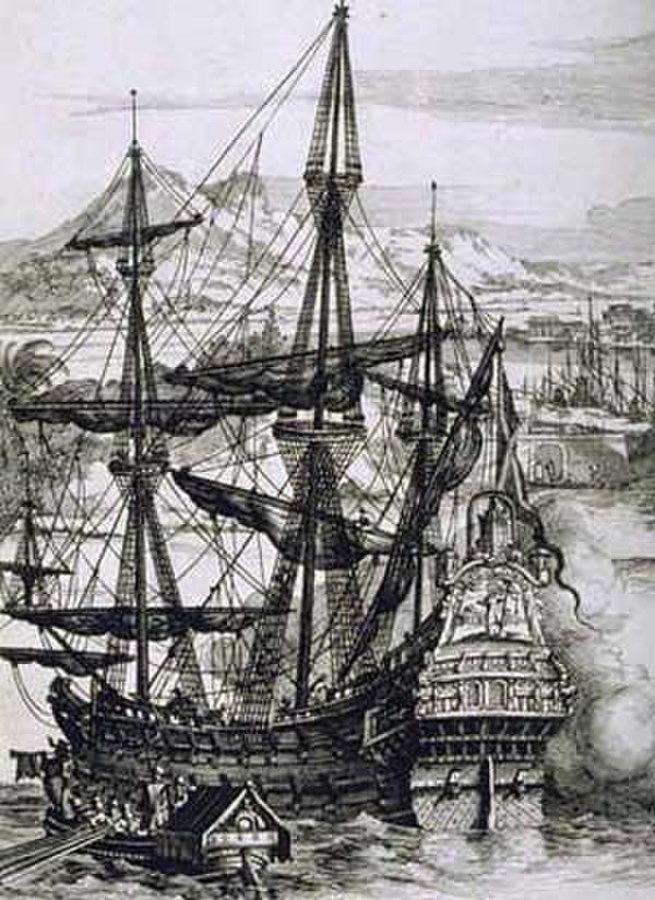Main Difference
The main difference between Galleon and Galley is that the Galleon is a ship type and Galley is a ship mainly propelled by oars.
-
Galleon
Galleons were large, multi-decked sailing ships first used by the Spanish as armed cargo carriers and later adopted by other European states from the 16th to 18th centuries during the age of sail and were the principal fleet units drafted for use as warships until the Anglo-Dutch Wars of the mid-1600s. Galleons generally carried three or more masts with a lateen fore-and-aft rig on the rear masts, were carvel built with a prominent squared off raised stern, and used square-rigged sail plans on their fore-mast and main-masts.
Such ships were the mainstay of maritime commerce into the early 19th century, and were often drafted into use as auxiliary naval war vessels—indeed, were the mainstay of contending fleets through most of the 150 years of the Age of Exploration—before the Anglo-Dutch wars brought purpose-built ship-rigged warships that thereafter dominated war at sea during the remainder of the age of sail.
-
Galley
A galley is a type of ship that is propelled mainly by rowing. The galley is characterized by its long, slender hull, shallow draft and low freeboard (clearance between sea and railing). Virtually all types of galleys had sails that could be used in favorable winds, but human strength was always the primary method of propulsion. This allowed galleys to navigate independently of winds and currents. The galley originated among the seafaring civilizations around the Mediterranean Sea in the late second millennium BC and remained in use in various forms until the early 19th century in warfare, trade and piracy.
Galleys were the warships used by the early Mediterranean naval powers, including the Greeks, Phoenicians and Romans. They remained the dominant types of vessels used for war and piracy in the Mediterranean Sea until the last decades of the 16th century. As warships, galleys carried various types of weapons throughout their long existence, including rams, catapults and cannons, but also relied on their large crews to overpower enemy vessels in boarding actions. They were the first ships to effectively use heavy cannons as anti-ship weapons. As highly efficient gun platforms they forced changes in the design of medieval seaside fortresses as well as refinement of sailing warships.
The zenith of galley usage in warfare came in the late 16th century with battles like that at Lepanto in 1571, one of the largest naval battles ever fought. By the 17th century, however, sailing ships and hybrid ships like the xebec displaced galleys in naval warfare. They were the most common warships in the Atlantic Ocean during the Middle Ages, and later saw limited use in the Caribbean, the Philippines and the Indian Ocean in the early modern period, mostly as patrol craft to combat pirates. From the mid-16th century galleys were in intermittent use in the Baltic Sea, with its short distances and extensive archipelagoes. There was a minor revival of galley warfare in the 18th century in the wars among Russia, Sweden and Denmark.
-
Galleon (noun)
A large, three masted, square rigged sailing ship with at least two decks.
-
Galley (noun)
A long, slender ship propelled primarily by oars, whether having masts and sails or not; usually referring to rowed warships used in the Mediterranean from the 16th century until the modern era.
-
Galley (noun)
A light, open boat used on the Thames by customhouse officers, press gangs, and also for pleasure.
-
Galley (noun)
One of the small boats carried by a man-of-war.
-
Galley (noun)
The cookroom or kitchen and cooking apparatus of a vessel or aircraft; sometimes on merchant vessels called the caboose.
-
Galley (noun)
An oblong oven or muffle with a battery of retorts; a gallery furnace.
-
Galley (noun)
An oblong tray of wood or brass, with upright sides, for holding type which has been set, or is to be made up, etc.
-
Galley (noun)
A proof sheet taken from type while on a galley; a galley proof.
-
Galley (noun)
A representation of a single masted ship propelled by oars, with three flags and a basket.
-
Galleon (noun)
a sailing ship in use (especially by Spain) from the 15th to the 18th centuries, originally as a warship, later for trade. Galleons were typically square-rigged and had three or more decks and masts
“a Spanish treasure galleon wrecked off the Florida Keys”
-
Galley (noun)
a low, flat ship with one or more sails and up to three banks of oars, chiefly used for warfare or piracy and often manned by slaves or criminals.
-
Galley (noun)
a large open rowing boat kept on a warship for use by the captain.
-
Galley (noun)
the kitchen in a ship or aircraft.
-
Galley (noun)
a printer’s proof in the form of long single-column strips, not in sheets or pages.

